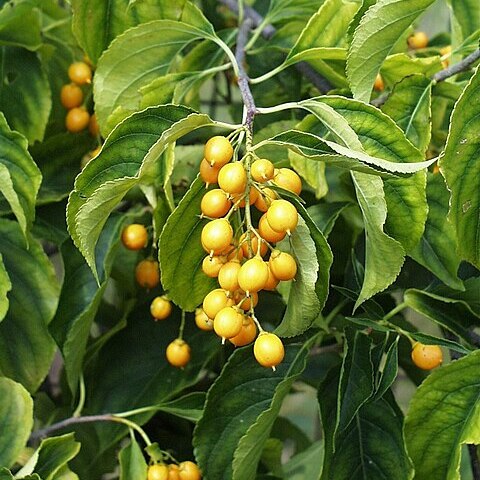Vines, <twining, polygamodioecious>. Branchlets terete. Leaves deciduous [persistent], alternate; stipules present; petiole present; blade margins denticulate; venation pinnate. Inflorescences terminal or axillary, panicles or cymes [racemes]. Flowers bisexual and unisexual, radially symmetric; perianth and androecium hypogynous; hypanthium absent; sepals 5, distinct; petals 5, white or greenish white; nectary intrastaminal, fleshy. Bisexual flowers: stamens 5, free from and inserted under nectary; staminodes 0; pistil 3-carpellate; ovary superior, 3-locular; placentation axile; style 1; stigmas 3; ovules 2 per locule. Staminate flowers: stamens 5; free from and inserted under nectary; staminodes 0; pistillode present. Pistillate flowers: staminodes 5, alternate with petals, undivided, not gland-tipped, <minute>; pistil 3-carpellate; ovary superior, 3-locular, placentation axile; style 1; stigmas 3; ovules 2 per locule. Fruits capsules, 3-locular, globose or subglobose, 3-lobed distally, apex not beaked. Seeds [1–]2 per locule, ellipsoid, not winged; aril red, completely surrounding seed. x = 23.
Scandent to twining shrubs, deciduous or evergreen, glabrous or pubescent, with oblong or circular gray lenticels; bud scales imbricate. Leaves alternate, subentire or serrate; stipules small, linear, deciduous. Inflorescences axillary or terminal, cymose, thyrsoid, or flowers solitary. Flowers unisexual, rarely bisexual, rarely dioecious, 5-merous, greenish or yellowish white. Disk membranous or fleshy, annular to cupuliform, entire or slightly 5-lobed, intrastaminal; anthers longitudinally dehiscent, introrse. Ovary 3-locular, separate from or slightly adnate to disk; ovules erect, 1 or 2 per locule. Capsule globose, yellowish, leathery, loculicidally dehiscent. Seeds 1-6, ellipsoid, enclosed in aril; aril carnose, red to orange-red.
Scandent shrubs. Leaves deciduous, alternate, petiolate. Inflorescences di-chasial, paniculate to racemose, solitary, axillary and/or terminal, pedunculate or sessile; pedicels articulated. Flowers usually unisexual and plants dioecious (bisexual in the Latin American species); calyx 5-lobed; petals 5; disc cup-shaped or fleshy and flat, entire or 5-lobed, stamens 5; ovary superior, free from the disc, 3-loculed, each 1-ovuled (in the Latin American species), ovules attached at the base of the ovary with a distinct cup-shaped aril towards the base. Fruit a capsule, 1-to 6-seeded; seeds enclosed in a fleshy crimson aril.
Scandent shrubs, usually dioecious. Leaves alternate, mostly serrate; stipules caducous. Flowers in terminal or axillary racemes or panicles. Perianth 5-merous. Stamens 5; anthers dorsifixed, versatile, dehiscing laterally or extrorsely; female flowers with staminodes. Ovary 3-locular; ovules 2 per locule, basally attached; stigma ± 3-lobed. Fruit a 3-valved, 3-locular capsule crowned by persistent remnants of style. Seeds 1–6, enveloped in a coloured, fleshy aril. Endosperm copious; embryo erect; colyledons thin, broadly spathulate.
Dioecious or polygamo-dioecious; fls 5-merous, the staminate with 5 stamens about as long as the pet, inserted on the margin of the cup-shaped disk, and with a vestigial pistil, the pistillate with vestigial stamens and a well developed ovary, stout columnar style, and 3-lobed stigma; ovules 2 per locule, collateral; fr 3-valved, each valve covering 1 or 2 seeds completely enclosed in a fleshy red aril; woody twiners with deciduous, alternate, serrulate lvs and small whitish or greenish fls. 30, mostly trop.
Evergreen or deciduous, usually scandent shrubs, often twining. Lvs alternate, petiolate, usually glabrous. Fls 5-merous, in axillary cymes or terminal panicles. Fr. a 3-celled capsule. Seeds 1-2 per cell, covered by a brightly coloured, fleshy aril.

